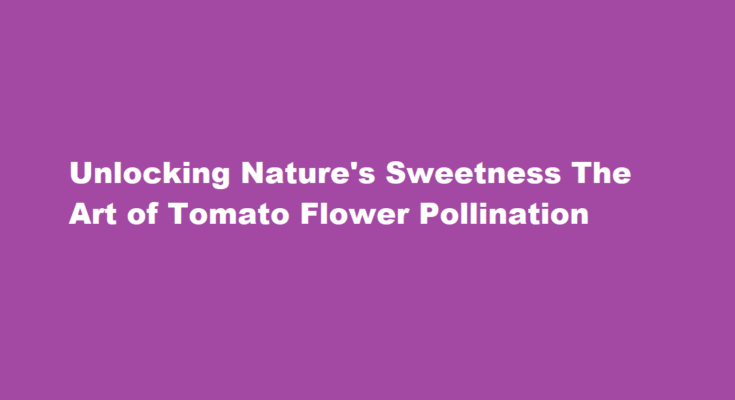Introduction
Tomatoes, with their vibrant colors and rich flavors, are a staple in many kitchens. These delicious fruits owe their existence to the intricate process of pollination, where pollen is transferred from the male reproductive organs to the female organs of the flower. While nature usually handles this vital task, certain circumstances may require human intervention. In this article, we will explore the art of tomato flower pollination, providing you with practical insights to ensure a successful fruit set and a bountiful tomato harvest.
Understanding Tomato Flower Structure
Before we delve into the techniques of tomato flower pollination, let’s understand the anatomy of these captivating blossoms. Tomato flowers are self-fertile, meaning they possess both male and female reproductive parts within the same flower. The male organs, located in the center of the flower, consist of the stamens that bear pollen. Surrounding the male organs is the female reproductive structure called the pistil, which comprises the stigma, style, and ovary. Successful pollination occurs when pollen is transferred from the stamens to the stigma.
Natural Pollination
In nature, tomato flowers are primarily pollinated by insects, particularly bees. Bees visit the flowers, collecting nectar and inadvertently transferring pollen in the process. While natural pollination is usually sufficient for a healthy tomato crop, certain conditions such as a lack of pollinators or indoor gardening may necessitate manual intervention.
Hand Pollination Techniques
Shake and Flick Method
- Gently shake the flower-bearing branch to release pollen from the stamens onto the stigma.
- Alternatively, use a soft brush or feather to flick the flowers, facilitating the transfer of pollen.
- Repeat this process for several flowers to maximize the chances of successful pollination.
Cotton Swab or Q-tip Method
- Take a clean cotton swab or Q-tip and gently rub it against the stamens to collect pollen.
- Transfer the collected pollen to the stigma of another flower, gently swirling it to ensure proper contact.
- Repeat the process for multiple flowers, using a new swab for each pollination to prevent cross-contamination.
Blower or Compressed Air Method
- Use a small handheld blower or compressed air to blow gently on the flowers, dislodging the pollen onto the stigma.
- Ensure the pressure is gentle to avoid damaging the delicate flower structures.
- Repeat the process on several flowers, ensuring a wide distribution of pollen.
Best Practices for Tomato Pollination
To maximize the success of tomato flower pollination, keep the following tips in mind
- Timing Pollination is most effective when flowers are fully open and receptive, typically in the morning when humidity is higher.
- Frequency Repeat the pollination process every 2-3 days to ensure a steady supply of pollen.
- Plant Health Maintain optimal growing conditions, including adequate water, sunlight, and nutrition, to enhance flower production.
- Variety Considerations Some tomato varieties, such as those with tightly closed flowers or reduced pollen production, may require more diligent hand pollination.
FREQUENTLY ASKED QUESTIONS
How do I know if my tomato flower is pollinated?
The flower’s petals begin to wither and fall off, and a little green bulb called an ovary develops at the flower’s base. Your tomato has just sprouted! If you notice this, then your flower has been successfully pollinated.
What is the time of pollination in tomatoes?
Tomato flowers must be pollinated within 50 hours of forming or they will abort. Pollination usually occurs between 10 a.m. and 4pm One of the most important factors affecting pollination is temperature.
Conclusion
The art of tomato flower pollination allows us to unlock the hidden sweetness of these delicious fruits, ensuring a bountiful harvest. While nature typically takes care of pollination, circumstances may arise that require human intervention. By understanding tomato flower anatomy and employing simple hand pollination techniques, gardeners can successfully ensure proper fertilization and fruit set. Remember to be gentle and patient, providing your tomato plants with the attention they deserve. So, roll up your sleeves, grab a cotton swab or shake those branches, and witness the magic of pollination as your tomato plants reward you with an abundance of plump and juicy fruits.
Read Also : The Art of Seed Germination A Comprehensive Guide



